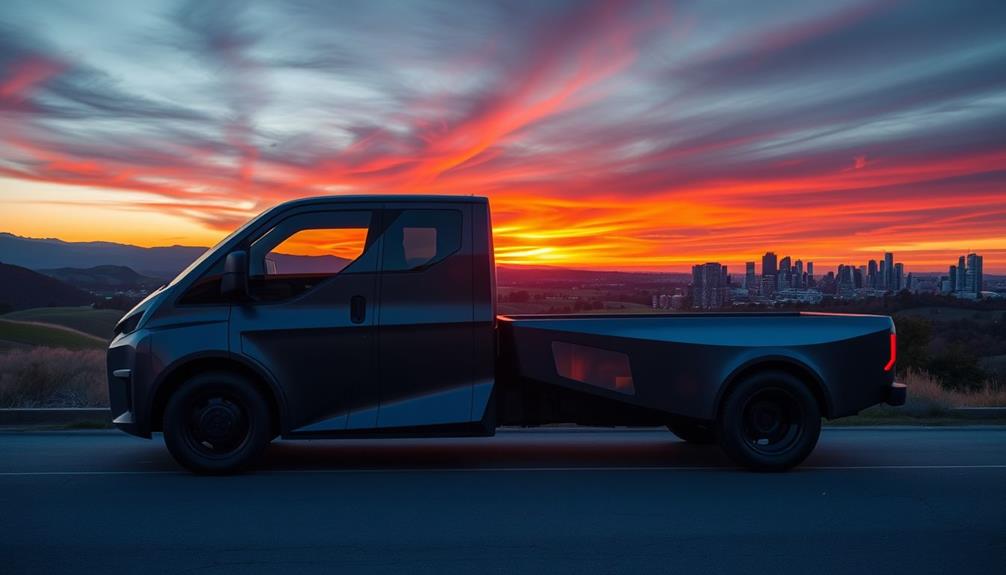The latest Tesla Cybertruck models have varying price points based on configurations. You can expect to pay around $62,985 for the upcoming rear-wheel-drive model. If you're looking at the Dual Motor, prices start at $81,895, while the high-performance Beast model begins at $101,985. Keep in mind, these prices reflect Tesla's cutting-edge electric technology and impressive features. Although the Cybertruck is pricier than competitors like the Ford F-150 Lightning and Rivian R1T, it offers superior specs. You might find it beneficial to check out further details on incentives and options available for buyers.
Key Takeaways
- The Dual Motor model starts at $81,895, while the Beast model begins at $101,985.
- An upcoming rear-wheel-drive model is expected to start at $62,985.
- Cybertruck pricing exceeds competitors like the Ford F-150 Lightning, starting at $57,090.
- Federal tax credits up to $7,500 may apply, but eligibility varies by model pricing.
- The base model price of $80,240 disqualifies it from federal EV tax credits.
Overview of the Cybertruck
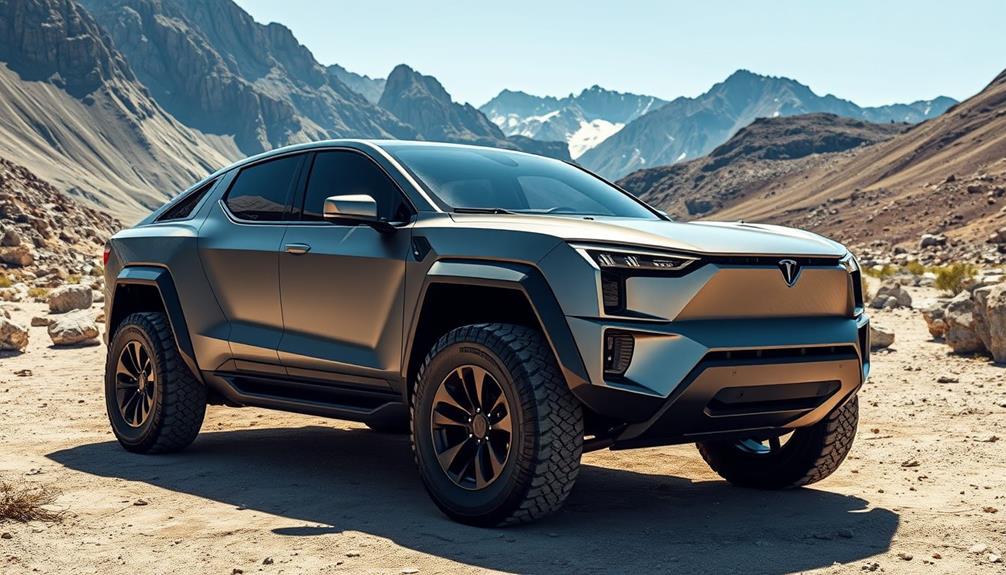
Exploring the 2024 Tesla Cybertruck reveals a striking vehicle that redefines the concept of an electric truck. With its unique bulletproof stainless-steel body, the Cybertruck looks unlike anything else on the market. You'll notice its futuristic design immediately, making a bold statement on and off the road.
Available in various configurations, you can choose between the 600-hp Dual Motor model or the powerful 834-hp Beast model, which boasts an impressive towing capacity of up to 11,000 pounds. The starting price for the Dual Motor is $81,895, while the Beast model starts at $101,985.
Performance-wise, the Cybertruck doesn't disappoint. It can accelerate from 0-60 mph in as little as 2.6 seconds, and it offers an estimated driving range of up to 340 miles.
Inside, you'll find a spacious cabin designed to accommodate five passengers, complete with a sleek 17-inch central touchscreen and a rear passenger screen for entertainment.
What sets the Cybertruck apart further is its adaptive air suspension, allowing for up to 17 inches of ground clearance, enhancing its off-road capabilities and ensuring you're ready for any adventure.
Pricing Breakdown

When it comes to pricing, the 2024 Tesla Cybertruck offers a range of options to suit different budgets. The starting price for the Dual Motor model is $81,895, while the high-performance Beast model comes in at $101,985.
If you're looking for a more budget-friendly option, an upcoming rear-wheel-drive model is expected to start at just $62,985, making it the most affordable choice in the lineup.
It's essential to note that while the Cybertruck's pricing reflects its premium position in the electric truck market, it does come in higher than competitors like the Ford F-150 Lightning, which starts around $57,090, and the Rivian R1T at $71,700.
You might also want to weigh potential savings from the federal tax credit, which could offer up to $7,500 off your purchase. However, keep in mind that some Cybertruck models exceed the threshold for these incentives, which could limit your eligibility.
Model Comparisons

In comparing the 2024 Tesla Cybertruck with its competitors, you'll find significant differences in pricing and features that cater to various preferences. The Cybertruck starts at $81,895 for the Dual Motor model, while the high-performance Cyberbeast variant is priced at $101,985. If you're looking for a more budget-friendly option, the upcoming rear-wheel-drive model is expected to start at $62,985, making it a notable choice within Tesla's lineup.
On the other hand, the Ford F-150 Lightning begins at a more accessible price of $57,090, appealing to those who want a capable electric truck without breaking the bank. The Rivian R1T starts around $71,700, offering a unique blend of features and performance. Meanwhile, the Chevrolet Silverado EV enters the competition with a starting price of approximately $70,000, adding to the diverse options available.
It's important to note that the Cybertruck's starting price exceeds the anticipated federal tax credit threshold of $80,000, potentially limiting consumer incentives.
As you weigh your options, consider how each truck's price aligns with your budget and desired features.
Performance Highlights

When it comes to performance, the Tesla Cybertruck doesn't disappoint.
You'll experience heart-pounding acceleration with the Dual Motor variant hitting 0 to 60 mph in just 4.1 seconds, while the Cyberbeast takes it up a notch at 2.6 seconds.
Plus, both models can tow up to 11,000 pounds, proving they're built for both speed and heavy lifting.
Acceleration and Speed Metrics
The 2024 Tesla Cybertruck impresses with its acceleration and speed metrics, particularly in the high-performance Cyberbeast model, which rockets from 0 to 60 mph in just 2.6 seconds. This remarkable acceleration showcases its exceptional speed capabilities, setting it apart in the electric pickup market.
Here's what you can expect from the Cybertruck's performance:
- Cyberbeast Model: 0 to 60 mph in just 2.6 seconds.
- Dual Motor Variant: 0 to 60 mph in 4.1 seconds, keeping things competitive.
- Top Speed: The Cyberbeast is governed at 130 mph, while the standard model reaches 112 mph.
- Ground Clearance: With adaptive air suspension, you'll enjoy up to 17 inches of clearance for enhanced off-road acceleration.
The combination of impressive acceleration and speed capabilities, along with a towing capacity of up to 11,000 pounds, makes the Cybertruck a powerhouse on both the road and off it.
Whether you're looking for thrilling speed or the ability to tackle rugged terrain, the Cybertruck doesn't disappoint. Experience performance like never before with Tesla's latest innovation.
Towing and Cargo Capacity
How much can the 2024 Tesla Cybertruck really handle? When it comes to towing, this truck shines with an impressive capacity of up to 11,000 pounds. Whether you're hauling a trailer for work or taking your toys on a weekend adventure, the Cybertruck's capabilities won't let you down.
With a cargo capacity of 120.9 cubic feet, you've got plenty of room for all your gear. The Cybertruck features a 6.5-foot cargo box, known as the "vault," which offers 100 cubic feet of lockable space. This means your items will stay safe and secure, no matter where you go.
Off-road enthusiasts will appreciate the Cybertruck's ground clearance of up to 17 inches, allowing it to tackle rugged terrain with ease. Plus, the adjustable air suspension means you can customize your ride for the driving conditions or load you're carrying.
Whether you're on a muddy trail or just cruising down the highway, the Cybertruck adapts to your needs. So, if towing and cargo capacity are high on your priority list, the Cybertruck is ready to impress.
Range and Charging

When you're considering the Tesla Cybertruck, its driving range is a key factor.
The Dual Motor model offers up to 340 miles, while the Cyberbeast model provides 301 miles, but with the Range Extender, those numbers can soar even higher.
Plus, thanks to rapid charging capabilities, you can add significant range in just minutes at a Supercharger station, making long trips more feasible.
Estimated Driving Range
With impressive capabilities, the 2024 Tesla Cybertruck boasts an estimated driving range of up to 340 miles for the Dual Motor model and 301 miles for the Cyberbeast variant under standard conditions. This means you can tackle long drives with confidence, knowing you have ample miles of range at your disposal.
If you opt for the Range Extender, you can push that range to an incredible 470 miles, making it an ideal choice for road trips or extended journeys.
Here are some key aspects of the Cybertruck's driving range:
- Estimated highway range at 75 mph: approximately 250 miles, ensuring practicality for highway driving.
- Fast charging capability: gain up to 136 miles of range in just 15 minutes using supercharging.
- Efficient charging time: from 10% to 90% in around 50 minutes with DC fast charging.
- Enhanced long-distance capabilities: thanks to the Range Extender option.
The 2024 Tesla Cybertruck's estimated driving range and fast charging features mean you won't have to worry about running out of power on your adventures.
Charging Speed and Options
The 2024 Tesla Cybertruck not only impresses with its driving range but also offers remarkable charging speed and options. With a powerful 123.0 kWh battery pack, you can expect an estimated driving range of up to 340 miles for the Dual Motor model.
When it comes to charging speed, the Cybertruck shines at supercharging stations, where it can achieve a maximum output of 250 kW. This means you can add up to 136 miles of range in just 15 minutes, making quick pit stops a breeze.
For longer trips, a full DC fast charge from 10% to 90% takes around 50 minutes, ensuring you're back on the road quickly. The Cybertruck is also designed for practical utility, with an estimated daily consumption of just 30 kWh.
This efficiency allows for off-grid charging options, making it easier than ever to maintain your vehicle's performance without relying solely on traditional charging infrastructure. Whether you're commuting or setting out on a road trip, the Cybertruck's charging speed and options help keep you powered up and ready for whatever adventure lies ahead.
Interior Features

Inside the 2024 Tesla Cybertruck, you'll find a high-tech environment designed for both comfort and utility. The interior features are impressive, showcasing Tesla's commitment to innovation and practicality.
You'll appreciate the spaciousness created for up to five passengers, along with ample storage options that make this vehicle incredibly functional. Check out these standout features:
- A central 17-inch touchscreen for all your infotainment needs, keeping essential controls at your fingertips.
- A 9.4-inch rear touchscreen that entertains backseat passengers and controls climate settings.
- On-board power outlets and a planned air compressor, perfect for off-grid adventures and outdoor activities.
- A 6.5-foot "vault" cargo box with 100 cubic feet of lockable storage, protected by a sturdy tonneau cover.
The Cybertruck's body is made from cold-rolled stainless steel, enhancing its durability and resistance to dents and rust.
With these interior features, you'll find that the 2024 Tesla Cybertruck isn't just an innovative vehicle; it's a versatile companion for your lifestyle. Whether you're commuting or tackling a weekend project, it's built to meet your needs.
Warranty Information
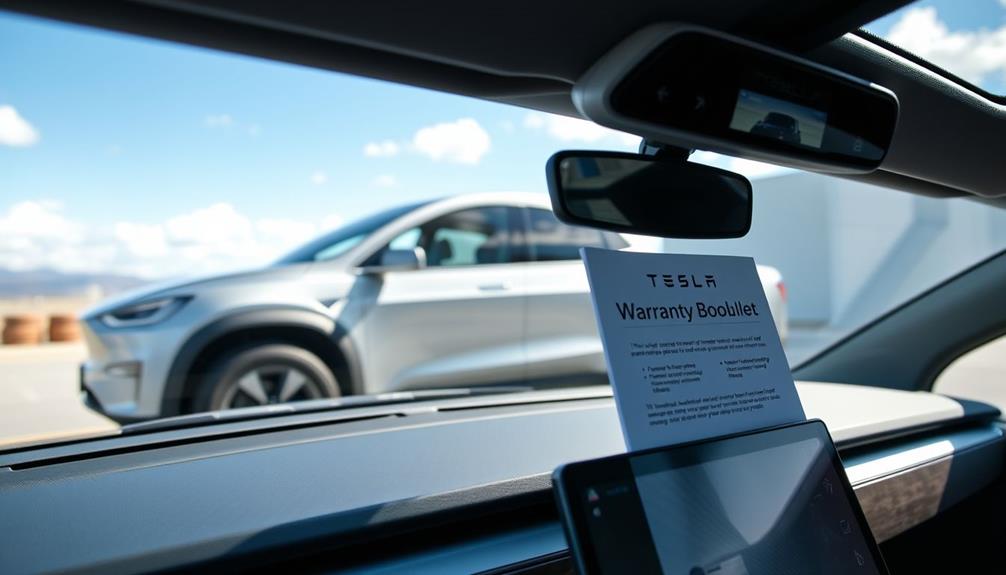
What kind of warranty can you expect with the 2024 Tesla Cybertruck? You'll find a limited warranty that covers 4 years or 50,000 miles, giving you basic protection for your vehicle. This means you can drive with peace of mind, knowing that most issues within this timeframe will be addressed without extra costs.
The powertrain warranty is even more impressive, extending up to 8 years or 150,000 miles. This provides long-term protection for essential components, ensuring your Cybertruck remains reliable over time.
Additionally, the battery components come with the same 8-year or 150,000-mile warranty, showcasing Tesla's commitment to battery longevity.
However, keep in mind that there's no complimentary scheduled maintenance offered with the Cybertruck. This aspect is important to reflect on as it may affect your overall ownership experience.
On a positive note, extensive coverage is available on current models, enhancing your warranty protection.
Competitive Landscape
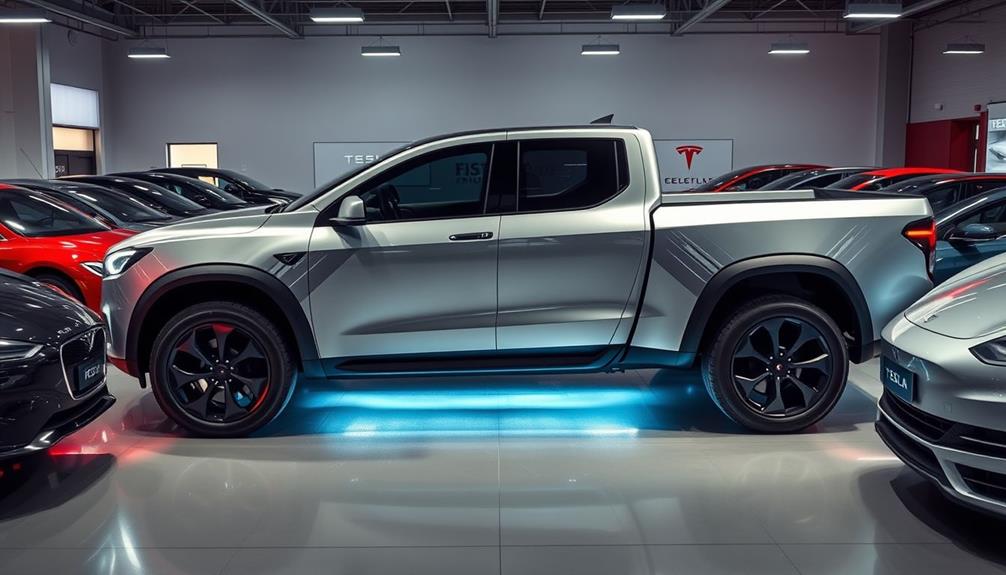
With the warranty details in mind, let's look at how the 2024 Tesla Cybertruck stacks up against its competitors. Priced at $81,895 for the Dual Motor model and $101,985 for the Beast, the Cybertruck sits in the premium electric pickup category.
This pricing strategy places it above several rivals, limiting potential eligibility for federal tax credits due to its higher cost.
Here's how the competition compares:
- Ford F-150 Lightning: Starting at $57,090, it's the most affordable option.
- Rivian R1T: Beginning at $71,700, it appeals to adventurers seeking luxury.
- Chevrolet Silverado EV: Priced around $70,000, it balances utility and modern features.
- GMC Hummer EV Pickup: At $98,845, it offers a luxury experience but at a premium price.
Tesla's Cybertruck, with its advanced features and performance, targets consumers willing to invest in a cutting-edge vehicle.
As competition heats up, it's clear that buyers will need to weigh their options carefully, considering both price and the potential for federal tax credits.
Tax Credit Eligibility
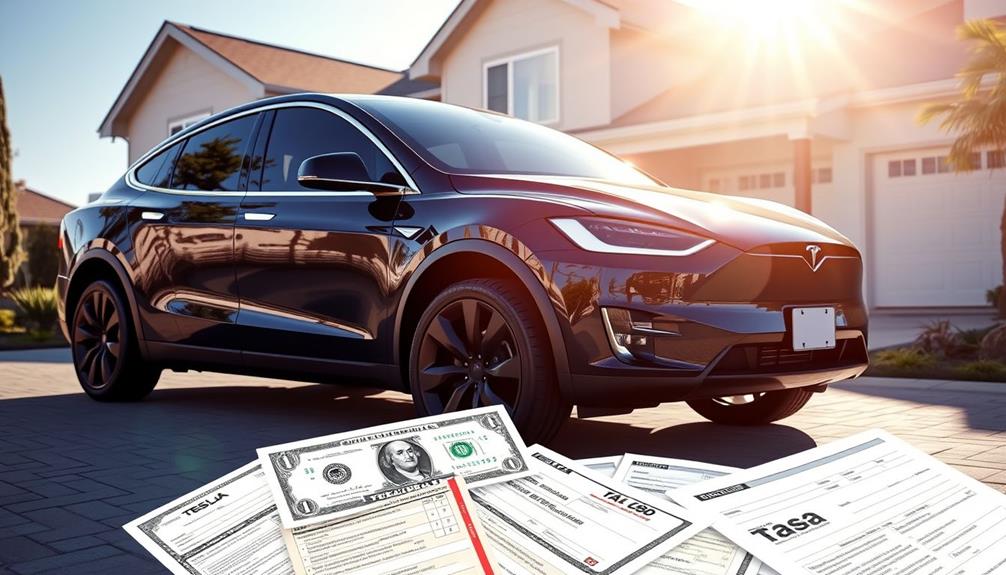
Steering through the world of electric vehicle tax credits can be tricky, especially when it comes to the Tesla Cybertruck. As it stands, the base model starts at $80,240, which disqualifies it from the federal EV tax credit that caps eligible vehicles at $80,000. However, there are still potential savings for buyers, depending on various factors. One potential way to save on a Tesla Cybertruck is to consider preowned Tesla prices. Buying a preowned Cybertruck that has already had the tax credit applied to it can significantly lower the out-of-pocket cost for the buyer. Additionally, some states offer their own EV tax credits or rebates, which could further reduce the price for those looking to purchase an electric vehicle.
| Criteria | Eligible Amount | Notes |
|---|---|---|
| Federal Tax Credit | Up to $7,500 | Based on pricing and income |
| State Incentives | Varies | Available in Texas |
| Future Models | TBD | May impact future tax eligibility |
As a buyer, your tax credit eligibility hinges on multiple criteria, including your income and the pricing of the vehicle. Even though the Cybertruck won't qualify for the federal tax credit now, future models might offer different price points that could change the game. Keep an eye on the evolving landscape, as it may afford you more options for tax credits down the line.
Frequently Asked Questions
How Much Will the New Tesla Cybertruck Cost?
You'll find the new Tesla Cybertruck starting at $81,895 for the Dual Motor model, with higher-end options reaching over $101,000. A more affordable rear-wheel-drive model is expected to start around $62,985.
How Long Is the Wait for Cybertruck?
You'll wait about a month for the dual-motor Cybertruck after ordering, but the Cyberbeast could take several months. Delivery schedules may change, so stay updated on Tesla's announcements for the latest information.
How Much Is a Cybertruck Beast?
The Cybertruck Beast starts at $101,985. With 834 horsepower, it accelerates from 0-60 mph in 2.6 seconds. You'll enjoy a range of 301 miles, expandable to over 440 with a Range Extender.
How Well Is the Cybertruck Selling?
With over 1.5 million pre-orders, the Cybertruck's selling like hotcakes! You'll find it's gaining traction in the market, thanks to its unique design and innovative features, attracting buyers enthusiastic for the premium electric truck experience.
Conclusion
In the grand marketplace of modern chariots, the Tesla Cybertruck stands as a knight, ready to conquer the roads with its unique armor and cutting-edge technology. As you weigh your options and decide on your trusty steed, remember that every price tag reflects the value of the adventure ahead. With its impressive features and potential savings, the Cybertruck could be your ticket to a thrilling journey. So saddle up and let the road unfold its stories before you!
